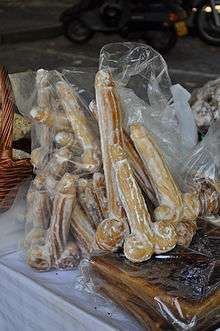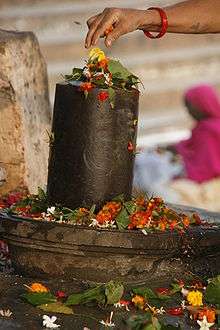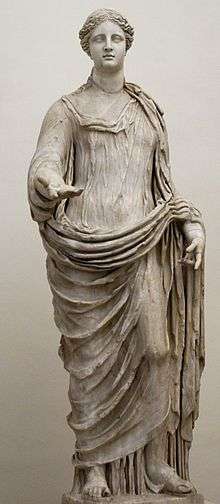Fertility and religion
Fertility was often mentioned in many mythological tales. In mythology, fertility deities exist in different belief systems or religions.
Fertility deities
A fertility deity is a god or goddess in mythology associated with fertility, pregnancy, and birth. In some cases these deities are directly associated with sex, and in others they simply embody related attributes.
Fertility rites

Fertility rites are religious rituals that reenact sexual acts actually or symbolically. They may include sacrifices of animals and at times humans.[1]
Demeter was the central deity in fertility rites held in classical Greece. Her rites included celebrating the change of seasons.[2] Most women's festivals related in some way to woman's proper function as a fertile being (believed to allow women to promote the fertility of crops).[3] Because of his link to the grape harvest, however, it is not surprising to see Dionysus associated with Demeter and Kore in the Eleusinian Mysteries.[4]
In Ancient Phoenicia, a special sacrifice was conducted in the harvest season to reawaken the spirit of the vine; while another winter fertility rite was performed to restore the spirit of the withering vine. The sacrifice included cooking a kid in the milk of its mother, a Canaanite custom which Mosaic law condemned and formally forbade.[5]
According to Ibn Ishaq, the Kaaba was formerly worshipped as a female deity.[6] Circumambulation was often performed naked by male and sometimes female pilgrims,[7] and worship associated with fertility goddesses.[8] Some have noted the apparent similarity of the Black Stone and its silver frame to the external female genitalia.[9][10]
Fertility symbols

Fertility symbols were generally considered to have been used since Prehistoric times for encouraging fertility in women, although it is also used to show creation in some cultures.
Wedding cakes are a form of fertility symbols. In Ancient Rome, the custom was for the groom to break a cakes over the bride’s head to symbolize the end of the bride’s virginal state, ensure fertility, and the beginning of her husband’s power over her.
Fertility symbols were used by Native Americans, the most common being a supernatural figure called Kokopelli, a fertility deity usually depicted as a hunchback, dancing flute player carrying a sack also shown with a large phallus. The deity presides over childbirth and agriculture.[11]
In Hinduism, Shiva is symbolized and worshiped in a form called Lingam, which shows his phallus merged with vulva of Shakti, his consort. Lingam is the most powerful fertility symbol in Hinduism, showing the critical union of Shiva and Shakti. Shiva is depicted with River Ganges and moon on his head. He wears garlands of snakes called Naga. The Ganga, moon and snakes are fertility symbols, and associated with fertility rituals in Hinduism.[12]
References
- Max Weber, The Sociology of Religion (London 1965) p. 236
- M. I. Finley, The World of Odysseus (Penguin 1967) p. 158
- J. Boardman et al eds., The Oxford History of the Classical World (Oxford 1991) p. 269-70
- F. Guirand ed., The New Larousse Encyclopedia of Mythology (1968) p. 160
- Guirand, p. 77-9
- Ibn Ishaq, Muhammad (1955). Ibn Ishaq's Sirat Rasul Allah - The Life of Muhammad Translated by A. Guillaume. Oxford: Oxford University Press. p. 85 footnote 2. ISBN 9780196360331.
- Ibn Ishaq, Muhammad (1955). Ibn Ishaq's Sirat Rasul Allah - The Life of Muhammad Translated by A. Guillaume. Oxford: Oxford University Press. pp. 88–9. ISBN 9780196360331.
- Rice, Edward (May 1978). Eastern Definitions: A Short Encyclopedia of Religions of the Orient. New York: Doubleday. p. 433. ISBN 9780385085632.
- Tate, Karen (January 1, 2006). Sacred Places of Goddess: 108 Destinations. San Francisco: Consortium of Collective Consciousness Publishing. p. 165. ISBN 9781888729115.
- Camphausen, Rufus (1996). The Yoni, Sacred Symbol of Female Creative Power. Vermont: Inner Traditions. Bear & Company. p. 134. ISBN 9780892815623.
- Young, John V. (1990). Kokopelli: Casanova of the Cliff Dwellers; The hunchbacked flute player. Filter Press. p. 18. ISBN 978-0-86541-026-8.
- William McCormack, in A. K. Ramanujan, Speaking of Śiva (Penguin 1979) p. 181
